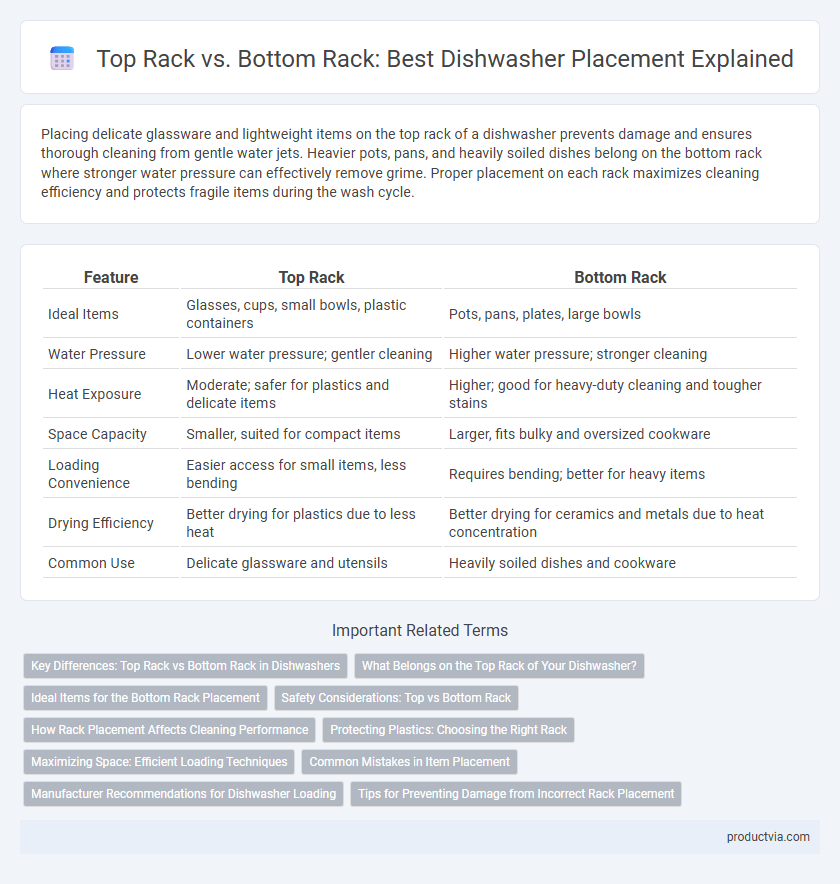Placing delicate glassware and lightweight items on the top rack of a dishwasher prevents damage and ensures thorough cleaning from gentle water jets. Heavier pots, pans, and heavily soiled dishes belong on the bottom rack where stronger water pressure can effectively remove grime. Proper placement on each rack maximizes cleaning efficiency and protects fragile items during the wash cycle.
Table of Comparison
| Feature | Top Rack | Bottom Rack |
|---|---|---|
| Ideal Items | Glasses, cups, small bowls, plastic containers | Pots, pans, plates, large bowls |
| Water Pressure | Lower water pressure; gentler cleaning | Higher water pressure; stronger cleaning |
| Heat Exposure | Moderate; safer for plastics and delicate items | Higher; good for heavy-duty cleaning and tougher stains |
| Space Capacity | Smaller, suited for compact items | Larger, fits bulky and oversized cookware |
| Loading Convenience | Easier access for small items, less bending | Requires bending; better for heavy items |
| Drying Efficiency | Better drying for plastics due to less heat | Better drying for ceramics and metals due to heat concentration |
| Common Use | Delicate glassware and utensils | Heavily soiled dishes and cookware |
Key Differences: Top Rack vs Bottom Rack in Dishwashers
The top rack in dishwashers is designed for smaller, more delicate items like glasses, cups, and small bowls, ensuring gentle cleaning and protection from high heat. The bottom rack accommodates larger, heavier items such as plates, pots, and pans, providing stronger water pressure and more space for thorough cleaning. Understanding these placements optimizes washing efficiency, prevents damage, and ensures all dishware is properly sanitized.
What Belongs on the Top Rack of Your Dishwasher?
The top rack of your dishwasher is ideal for delicate items such as glasses, cups, and plastic containers that can warp or melt under high heat. Lightweight utensils, small bowls, and dishwasher-safe plastics should also be placed on the top rack to ensure an effective, gentle clean. Positioning these items on the top rack helps prevent damage and allows water jets to reach every surface for thorough washing.
Ideal Items for the Bottom Rack Placement
The bottom rack of a dishwasher is ideal for placing large cookware such as pots, pans, and baking dishes due to its sturdier design and increased space. Plates, bowls, and cutting boards also fit best on the bottom rack, ensuring thorough cleaning with stronger water jets targeting these items. Heavy or bulky kitchenware benefits from the bottom rack's open layout and proximity to the spray arms for optimal washing performance.
Safety Considerations: Top vs Bottom Rack
Placing sharp items like knives on the top rack reduces injury risk during unloading, while heavier pots and pans belong on the bottom rack to prevent overloading and dishwasher damage. The top rack's elevated position keeps delicate glassware safer from intense heat and water pressure compared to the bottom rack. Proper placement minimizes hazards and ensures optimal cleaning performance for all dishware types.
How Rack Placement Affects Cleaning Performance
Top rack placement in a dishwasher is ideal for smaller, delicate items like glasses and cups, as it avoids intense heat and water pressure, preserving fragile materials while ensuring thorough cleaning. The bottom rack, subjected to higher water pressure and temperature, effectively removes tough food residues on larger items such as pots, pans, and plates, enhancing overall cleaning performance. Properly distributing items between the top and bottom racks maximizes water circulation and detergent exposure, leading to optimized cleanliness and efficient drying.
Protecting Plastics: Choosing the Right Rack
Plastics should be placed on the top rack of a dishwasher to avoid warping and melting caused by the higher heat near the heating element at the bottom. The top rack provides gentler water pressure and lower temperatures, which helps preserve the integrity of plastic containers, lids, and utensils. Proper placement on the top rack extends the lifespan of plastics and reduces the risk of damage during dishwashing cycles.
Maximizing Space: Efficient Loading Techniques
Maximizing space in dishwasher loading requires strategic placement on the top and bottom racks, with taller items like pots and pans best suited for the bottom rack while delicate glassware fits securely on the top rack. Utilizing adjustable racks and fold-down tines enhances space efficiency by allowing flexible arrangements tailored to various dish shapes and sizes. Properly spacing items ensures optimal water flow and cleaning performance while preventing overcrowding and potential damage.
Common Mistakes in Item Placement
Placing large pots and pans on the top rack in a dishwasher blocks water spray, leading to inefficient cleaning and residue buildup. Small items like lids and plastic utensils often get misplaced in the bottom rack, causing them to either not be cleaned properly or to wedge into the rotating arms. Overcrowding the top rack with heavy dishes compromises water circulation and can result in poor washing performance and potential damage to delicate items.
Manufacturer Recommendations for Dishwasher Loading
Manufacturer recommendations for dishwasher loading emphasize placing delicate items such as glasses and lightweight plastics on the top rack to prevent damage and ensure thorough cleaning. Heavier utensils and pots should be positioned on the bottom rack to accommodate larger spray arms and maximize water pressure efficiency. Following these guidelines improves washing performance and extends the longevity of both dishes and dishwasher components.
Tips for Preventing Damage from Incorrect Rack Placement
Place delicate items like glassware and plastic containers on the top rack to minimize exposure to intense heat and water pressure, reducing the risk of warping or cracking. Heavy pots, pans, and sturdy dishes should be positioned on the bottom rack to ensure secure placement and thorough cleaning without obstructing the spray arms. Avoid overcrowding either rack to maintain optimal water flow and prevent items from knocking into each other during the wash cycle.
Top rack vs bottom rack for dishwasher placement Infographic

 productvia.com
productvia.com